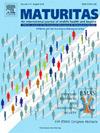绝经和动脉粥样硬化性心血管疾病的风险:来自英国女性生物银行队列的见解
IF 3.6
2区 医学
Q2 GERIATRICS & GERONTOLOGY
引用次数: 0
摘要
绝经引起的激素和代谢变化可能增加动脉粥样硬化性心血管疾病(ASCVD)的风险。然而,除了衰老,更年期对ASCVD风险的影响仍存在争议。本研究调查了绝经期与ASCVD风险之间的关系。方法:我们分析了来自英国生物银行(UK Biobank)的222,2007名女性的数据,排除了既往有心血管疾病或绝经状态不确定的女性。ASCVD风险采用合并队列方程估计。高ASCVD风险定义为10年风险≥7.5%。为了解决缺失的数据,使用完全条件规范方法对区域剥夺指数(ADI)进行了多次插值。多变量回归模型用于评估更年期与ASCVD风险之间的关系,调整年龄、社会经济、生活方式、代谢和临床因素。结果绝经后妇女(n = 158,572)的ASCVD预估风险显著高于绝经前妇女(n = 63,435) (3.75% vs. 0.81%; p < 0.001)。绝经后妇女ASCVD高危患病率为9.65%,绝经前妇女为0.41% (p < 0.001)。完全调整后,绝经与较高的ASCVD风险独立相关(β = 0.56%; 95% CI 0.54-0.58),高ASCVD风险可能性增加18% (OR = 1.18; 95% CI 1.01-1.37)。这种关联在60岁以下的女性中最为明显,60岁以上的女性则无显著关联。结论:绝经与ASCVD风险增加独立相关,尤其是60岁以下的女性。这些发现强调了在中年妇女心血管风险评估中考虑绝经状态和实施有针对性的预防策略的重要性。本文章由计算机程序翻译,如有差异,请以英文原文为准。
Menopause and risk of atherosclerotic cardiovascular disease: insights from a women's UK Biobank cohort
Background
Menopause induces hormonal and metabolic changes that may increase the risk of atherosclerotic cardiovascular disease (ASCVD). However, the contribution of menopause to ASCVD risk, beyond aging, remains debated. This study investigated the association between menopause and ASCVD risk in a large population-based cohort.
Methods
We analyzed data from 222,007 women in the UK Biobank, excluding those with prior cardiovascular disease or uncertain menopausal status. ASCVD risk was estimated using pooled cohort equations. High ASCVD risk was defined as a 10-year risk ≥7.5 %. To address missing data, multiple imputations for the Area Deprivation Index (ADI) were performed using a fully conditional specification approach. Multivariable regression models were used to assess the association between menopause and ASCVD risk, adjusting for age as well as socioeconomic, lifestyle, metabolic, and clinical factors.
Results
Postmenopausal women (n = 158,572) had significantly higher estimated ASCVD risk than premenopausal women (n = 63,435) (3.75 % vs. 0.81 %; p < 0.001). The prevalence of high ASCVD risk was 9.65 % in postmenopausal women versus 0.41 % in premenopausal women (p < 0.001). After full adjustment, menopause was independently associated with a higher ASCVD risk (β = 0.56 %; 95 % CI 0.54–0.58) and an 18 % increased likelihood of high ASCVD risk (OR = 1.18; 95 % CI 1.01–1.37). The association was strongest among women aged under 60 years, with no significant association observed beyond 60 years.
Conclusion
Menopause is independently associated with increased ASCVD risk, particularly in women aged under 60 years. These findings highlight the importance of considering menopausal status in cardiovascular risk assessment and implementing targeted prevention strategies in midlife women.
求助全文
通过发布文献求助,成功后即可免费获取论文全文。
去求助
来源期刊

Maturitas
医学-妇产科学
CiteScore
9.10
自引率
2.00%
发文量
142
审稿时长
40 days
期刊介绍:
Maturitas is an international multidisciplinary peer reviewed scientific journal of midlife health and beyond publishing original research, reviews, consensus statements and guidelines, and mini-reviews. The journal provides a forum for all aspects of postreproductive health in both genders ranging from basic science to health and social care.
Topic areas include:• Aging• Alternative and Complementary medicines• Arthritis and Bone Health• Cancer• Cardiovascular Health• Cognitive and Physical Functioning• Epidemiology, health and social care• Gynecology/ Reproductive Endocrinology• Nutrition/ Obesity Diabetes/ Metabolic Syndrome• Menopause, Ovarian Aging• Mental Health• Pharmacology• Sexuality• Quality of Life
 求助内容:
求助内容: 应助结果提醒方式:
应助结果提醒方式:


